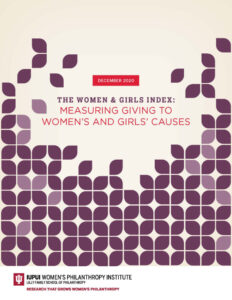What is this Report?
The report focuses builds on prior research of the Women & Girls Index with the inaugural report in 2019 that looked at 2016 data. The report adds additional data including 2012-2015 and 2017. The report looks at the impact of the 2016 presidential election and Women’s march had on women’s and girl’s causes but does not focus on #MeToo, Time’s Up, and COVID-19 since these events happened after the report study period.
What are key findings from the article?
- Causes for women and girls saw an increase of 36.4% in philanthropy from 2012-2017. was comparable to the total philanthropic support growth of 36.9% over the same period. Government grants also increased to these causes by 34.4%.
- But support of causes for women and girls still represents a small percentage of total philanthropy giving at 1.6%. “A 2020 study found that grants to women and girls of color totaled $356 million — about 0.5% of the $66.9 billion contributed by foundations in 2017.”
- Among giving to women and girls, women’s health remains the most popular area for giving. Causes that focused on reproductive health and gender-based violence saw significant growth, 85.2% and 41.6% respectively. Reproductive health organizations saw a 33.7% increase in giving in 2017. Concerns over the election most likely fueled the increase. However, support for women’s and girl’s organizations in education saw a decrease from 17% in 2016 to 15% in 2017.
- After 2016, alternative forms of giving saw an increase in donations to women and girl’s causes including GoFundMe and Donor Advised Funds. Schwab Charitable was second in the list of top DAF grant recipients. DAF giving, however, was rising before the 2016 election. In 2012-2015, giving to women and girl’s causes from DAFs was 3.1% of DAF grant dollars.
- Like many organizations in COVID-19 times, leaders at women’s and girl’s organizations stress the importance of unrestricted giving and small gifts. Interviewed leaders also stressed engaging folks in non-monetary ways such as postcard writing or phone banking.
What can I do as a result?
- Engage your female donors. The report adds to the resounding literature about the importance of cultivating women donors. In the past few years, we’re seeing more and more billionaire women donors making headlines. A 2016 Women Gives report found that women are more likely than men to give to women’s and girl’s causes. They are also more likely to give greater amounts to these causes. Accordingly, nonprofits need to better work at engaging female donors. Engage them – such as phone banking, writing postcards, etc.
- Citing the importance of small gifts, nonprofits need to thank every donor – including the ones giving small amounts. It makes people feel more engaged and more likely to give again. Plus, there may be diamonds in the rough that could give more in the future depending on how they are treated.
- Ask for unrestricted gifts. There have been countless articles about the importance of asking donors during the age of COVID-19, as well as calls for foundations and other giving entities to give unrestricted to reduce the burden on nonprofits during these challenging times. We’re adding to that by saying your organization might want to consider asking for unrestricted funding and explain why it’s critical.
Additional Resources
- The Women & Girls Index: Measuring Giving To Women’s And Girls’ Causes | Lily Family School of Philanthropy – Women Gives 2021
- Giving to Women and Girls: Who Gives, And Why? | Lily Family School of Philanthropy – Women Gives 2016
- How Women Are Changing the Philanthropy Game | NYT 2021
- There are no major donors! And other surprising insights from Penelope Burk | Prospect Research Institute 2019
- Gender Matters: A Guide to Growing Women’s Philanthropy | CASE Kathleen E. Loeh


1 thought on “Women Gives: The Women & Girls Index: Measuring Giving To Women’s And Girls’ Causes (December 2020)”